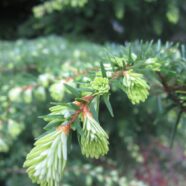
It is May and I am bedazzled by the lime-green tips emerging from evergreen trees. I have been waiting patiently. First the tiny brown buds, tight fists at the tips of branches. Slowly they swell, and then papery brown coating falls away in wind or rain, revealing tender nubs of baby needles. Now they are everywhere – waving on the tips of branches like bejeweled dancers. My mouth waters as I imagine the bounty they offer – spruce lemonade, Douglas fir sorbet or hemlock tip sun tea – all so refreshing on a warm spring day.
Evergreen conifer trees define our Pacific Northwest landscape. They are the giants that house many of our wild plants and animals. When I see their new growth something in me is relieved and gladdened – the forest is alive and the medicine it holds is still sheltered. We have many native varieties of evergreens with new needle growth that can be used for food and medicine. Cedar and juniper do not have needles and are not used in this way. Pine is rare in Western Washington, but if I lived in dryer places I would include it as well. Here are the species I most often harvest tips from:
Douglas Fir or Pseudotsuga menziesii. I grew up under the towering giants of Douglas fir – their deep furrowed brown bark the backdrop of my outdoor world. I love their smell on hot summer days and their large hanging cones that appear as if they are hiding the front half of dozens of chipmunks. Douglas fir is not classified as a true fir – it was just named this by a European botanist who visited our region in the late 1700’s. The leaves are distinctive because they are all the same length, are pointed at the tip (but do not hurt you when you brush up against them) and are spirally arranged all around the branch. This is very different than the flat sprays of true fir or the needle-like tips of spruce.
Douglas fir buds
Douglas fir new growth
True Fir or Abies spp. There are many firs in our region including Pacific silver fir, grand fir, noble fir, and in the high country, subalpine fir. All true firs have cones that are erect. Bark on younger trees is often smooth and silvery with blisters that contain sap. Fir branch sprays often appear flat. Leaves grow in distinctive patterns – either growing flat against the twig like pacific silver fir, in two distinct horizontal rows like grand fir or all tending to turn upward like noble fir and subalpine fir.
Grand fir tips
Hemlock or Tsuga heterophylla. Hemlock is a “climax tree” in our forest meaning that it grows longer and towers higher than other trees. If untouched by humans or natural disaster, our forests would be dark woodlands of giant hemlock. Hemlock has a distinctive drooping top and feathery drooping branches. In wind these trees remind me of graceful dancing cranes. Bark is silvery brown and furrowed – but not so deeply scored as Douglas fir. Cones are small – only a couple of centimeters long. Leaves are different lengths and are arranged randomly along branches. Many people have heard that hemlock tree is poisonous but this is because it is confused with “poison hemlock”, an entirely different plant from the carrot family.
 Spruce or Picea sp. The easiest way to identify a spruce is to touch the needles. If they are very stiff and sharp, it is a spruce. Sitka spruce trees (Picea sitchensis) grace wet coastal forests from Oregon to Alaska. Along the rocky coastline they take the form of sideways bending sculptures molded by wind and rain. They seldom venture to higher elevations or dry climates. When I lived on the Oregon coast I often visited ancient spruces with tall buttressing roots that reach out making small walls. A child or an imaginative adult could get lost in the nooks. Outer spruce roots can grow straight and be pliable enough to split and make baskets with. Coast Salish weavers have traditionally utilized spruce roots to weave water-tight baskets. Sitka spruce was heavily logged during World Wars I and II because it was used to make American and British airplane frames and propellers. For more on white spruce see “Spruce Wisdom from Alaska” below.
Spruce or Picea sp. The easiest way to identify a spruce is to touch the needles. If they are very stiff and sharp, it is a spruce. Sitka spruce trees (Picea sitchensis) grace wet coastal forests from Oregon to Alaska. Along the rocky coastline they take the form of sideways bending sculptures molded by wind and rain. They seldom venture to higher elevations or dry climates. When I lived on the Oregon coast I often visited ancient spruces with tall buttressing roots that reach out making small walls. A child or an imaginative adult could get lost in the nooks. Outer spruce roots can grow straight and be pliable enough to split and make baskets with. Coast Salish weavers have traditionally utilized spruce roots to weave water-tight baskets. Sitka spruce was heavily logged during World Wars I and II because it was used to make American and British airplane frames and propellers. For more on white spruce see “Spruce Wisdom from Alaska” below.
When and How to Harvest: Young tips are harvested when they are limey green and tender. Pinch off the new growth here and there – making sure to not to gather too much in one place. Remember that you are pruning. I usually use the tips fresh but I have heard that you can dry them for tea if you have a good area for drying (here in Olympia and other damp climates this is hard to do without a woodstove or a warm and well-ventilated area in your house). Tips can be preserved in the fridge for several days.
Food and Medicine
I look forward to this refreshing flavor of spring. Tree flavors vary but you will pick up bright elements of citrus and pine with earthy undertones. Many have an astringent quality that makes you pucker up. When I ingest the new growth I feel like I am taking in the vitality of the trees. You don’t need too many – just a little handful feels like enough to satisfy. Because these tree tips are packed with Vitamin C and electrolytes, you could equate them with Gatorade or Emergen-C, but without the sugary downside. Indeed – many Northwest Native People have eaten spring tips to ward off thirst and hunger. They have also been used to combat scurvy, colds, coughs and fatigue.
Making Evergreen Tree Tip Tea
You can prepare a hot tea by taking a handful of spring tips per 3-4 cups of boiled water. Cover and let steep about 10 minutes. My favorite is a sun tea. This brings out the bright aromatics and the Vitamin C without the tannins. Nothing is as refreshing as a cup of Douglas fir sun tea after a hard day of working in the garden. I add 2 handfuls of tips in a quart jar and cover with room temperature water. Place in a warm spot and let sit 3-8 hours. Strain and drink straight, or mix with lemon or lime juice and sweetener.
Evergreen Tree Tip Syrup
You can make a simple syrup that can be used on pancakes, in tea, over ice cream, in sauces, and to glaze meats. This is really simple to prepare and you can use any of the many varieties of fir, spruce or hemlock.
- 1 cup spring fir, hemlock or spruce tips
- 1 cup water
- 1 cup sugar, demerara, turbinado or white
Place tree tips in an 8 ounce glass container. Cover with water, close lid and place in a warm place (preferably in the sun). Strain and place the liquid in a small sauce pan. Add sugar, turn on medium heat, and stir constantly until the sugar is dissolved. Place in a glass jar and keep refrigerated. This syrup will last several weeks. Demerara is a natural brown sugar and turbinado is raw sugar. These both have a richer and more complex flavor but white sugar will work fine too.
Spruce Lime Sorbet
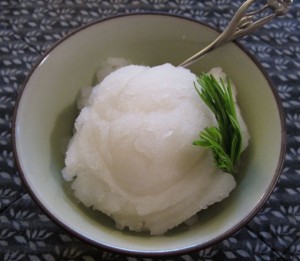 This light and refreshing dessert is sure to please. Hemlock and fir tips can also be used. You can experiment with adding citrus juice, herbs like lemon verbena, rose or lemon balm, or fruit like strawberry and blueberry.
This light and refreshing dessert is sure to please. Hemlock and fir tips can also be used. You can experiment with adding citrus juice, herbs like lemon verbena, rose or lemon balm, or fruit like strawberry and blueberry.
- 2 cups spruce tips
- 4 cups water
- 1/3 cup honey
- 3 tablespoons lime juice
Rinse spruce tips then place in a quart mason jar. Fill with water and cover with a lid. Set in the sun or another warm place for 4-8 hours. Heat honey and lime juice in a sauce pan until the honey is thin but not boiling. Strain the spruce tea into the sauce pan and stir just until the honey is mixed. Remove from heat, cover and cool to room temperature. Place in an ice cream maker and follow directions. Sorbet should be used within about 7 hours or it will get too icy. Serves 6
Other recipe ideas:
In Jennifer Hahn’s lovely book Pacific Feast she features a recipe for Moroccan-spiced lamb chops with Matanuska Valley carrot puree and spruce tip syrup. How could you go wrong!
For a playful blog on spruce and ideas on how to make “Poor Man’s Balsalmic” go to www.morganbotanicals.com
Pitch
I am always on the hunt for pitch. Spring is a good time to gather it because tree sap is running. As I walk or drive through forested areas I scan for trees that have been hit by lightening or injured in some other way. Sap oozes over the wound – protecting and healing the tree. Perhaps it will have a little extra to share… I have been known to screech on the breaks – slowing from sixty to stop in no time to gather from a giving tree. I use it for medicine and for incense. Pitch has traditionally been used for other utilitarian purposes including starting fires and waterproofing boat seams. Generally, pitch is antimicrobial and immune stimulating. It can be used straight on cuts, scrapes and insect bites. A tried-and-true remedy is fir pitch on mosquito bites. First dap a bit of sap over the bite, then place a small leaf like huckleberry over it to make a little green band aid. This will relieve itching and help the bite to heal faster.
Helpful hint: Pitch can be a blessing or a curse – if you sit on a big glob of it or worse yet, get it in your hair, oil will dissolve it. When I was a kid this happened to me. I got the pitch out of my hair with peanut butter – the oil was the key factor here. Alcohol will also dissolve pitch but the higher proof the better.
Spruce Wisdom from Alaska, and More on Pitch
I was lucky enough to attend the Alaska Native Tribal Health Consortium’s Alaska Plants for Food and Medicine Symposium recently. Karin Bodony taught an excellent class on the many uses of white and black spruce. First, I learned how important white spruce is to the Koyukon People. It is the equivalent of cedar here in Western Washington. Some of the many things spruce provides include shelter, baskets, dyes, bandages, medicine, carving, firewood, tanning, waterproofing, incense, spiritual uses, and chewing gum. Almost every part of spruce has a special Athabaskan name, and many of the meanings illustrate uses. For example “ts’ebaa kent’oh” means under the shelter of a spruce tree. Those who sleep under the boughs will be comforted as they rest on soft matted needles, smell the sweet aroma and find protection from this benevolent spirit. Sign me up!
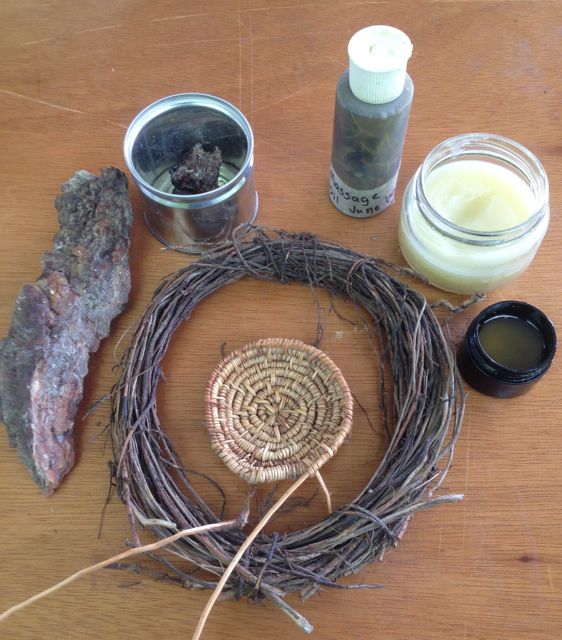 Karin makes salves and ointment from spruce pitch. She gathers the young pitch and mixes it with a little olive oil to make an antibacterial and delicious smelling medicine that is the consistency of honey. This can be used straight or added to salve. Older pitch gets hard but you can break it up and heat it in olive oil to help dissolve it. After you have heated it gently for several hours you can strain it with muslin cloth and use it straight or turn it into a salve by adding beeswax.
Karin makes salves and ointment from spruce pitch. She gathers the young pitch and mixes it with a little olive oil to make an antibacterial and delicious smelling medicine that is the consistency of honey. This can be used straight or added to salve. Older pitch gets hard but you can break it up and heat it in olive oil to help dissolve it. After you have heated it gently for several hours you can strain it with muslin cloth and use it straight or turn it into a salve by adding beeswax.
Spruce needles are very aromatic and also have antimicrobial and immune stimulating properties. Even older needles can be made into a delicious and medicinal tea. They are steeped in hot water for 15-20 minutes. Karin also showed us how to make spruce massage oil by simply chopping up spruce needles, placing them in a plastic jar and covering them with extra virgin olive oil. After a week of infusing it has a very uplifting and invigorating smell. No need to strain out the needles – the flip top lid does the straining for you.
I love witnessing the creativity and passion that people bring to their plant preparations. Through sharing ideas and experiences we lift each other up and push the knowledge forward. Go Karin!
27 Comments
Trackbacks/Pingbacks
- Canning Spruce Tip Jelly | The Homestead Survival - […] Spruce Lime Sorbet – https://wildfoodsandmedicines.com/fir-hemlock-and-spruce-tips/ […]
- Forage Blue Spruce in May - […] the other day I saw a post for spruce syrup, which I regrettably cannot find again. But I did…
- Recipes for Salves | Welcome to the life of Sew Yupik and Nikki - […] https://wildfoodsandmedicines.com/fir-hemlock-and-spruce-tips/ […]
- Benefit of Spruce Tips ~ Mountain Girl Camp - […] Spruce Tip Tea, Syrup, and Sorbet […]
- Fir weather Mountain - […] Fir, Hemlock and Spruce Tips – Wildfoodsandmedicines – I know a traditional recipe of fir syrup used to cure…




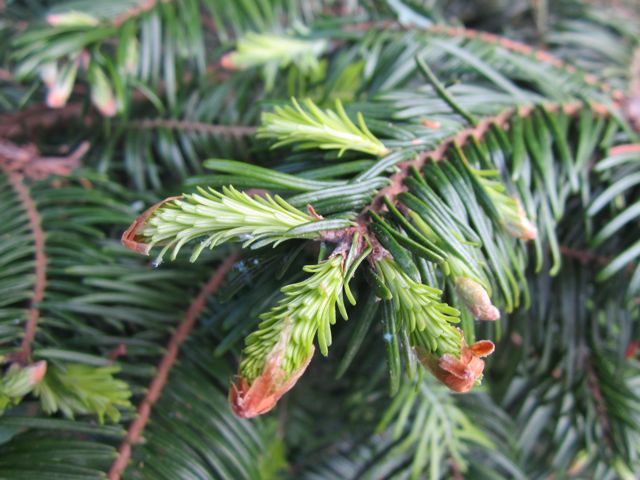
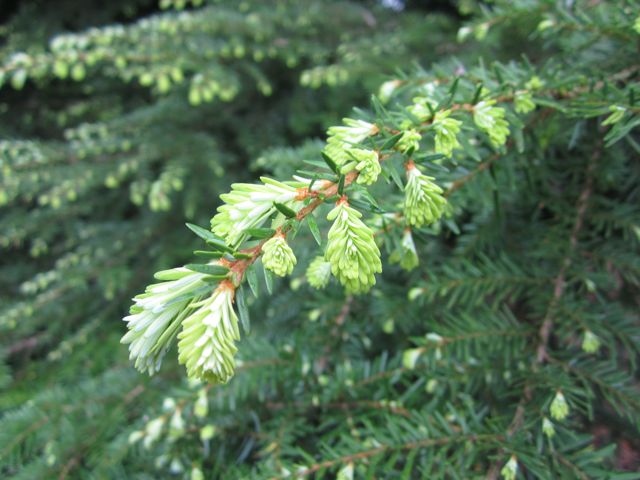
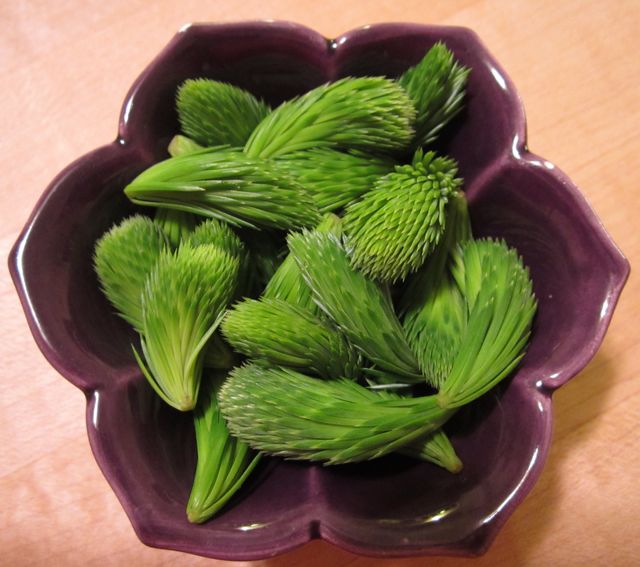

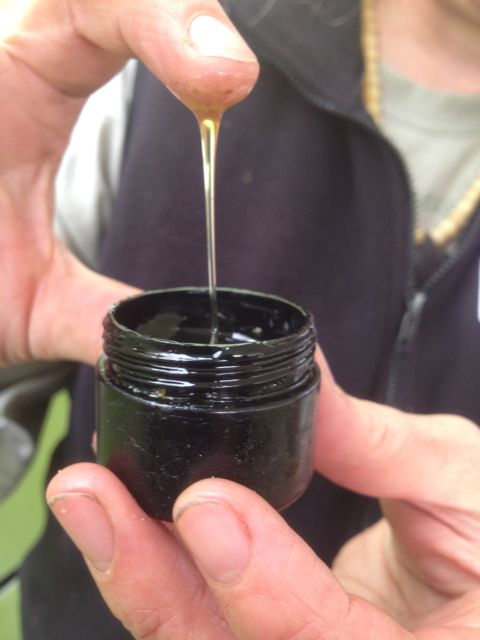
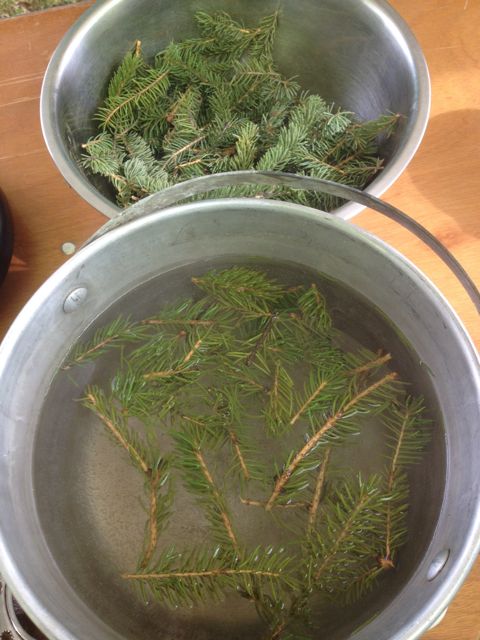
Thanks for this! I can’t wait for the new growth to come out so I can try some of these recipes! 🙂
Loved your write up! Thank you for the inspiration!
Thank you. I have huge spruce trees. I’ve been looking for information exactly like this.
I’ve got a Leyland Cypress that drips sticky sap on a vehicle that occasionally is parked underneath it. Is there a certain time of year that the sap runs so that I can avoid this in the future? Thank you.
It tends to run more in late summer when it is hot but it can vary based on the species and weather conditions. Sap is generally immune stimulating and antimicrobial so you could use it topically for cuts, bites and stings. It can also be used as incense.
Hello Elise,
Are the coniferous trees mentioned above okay to use if they have been growing in urban areas?
Peace, Lesleii
Hi there. I would not harvest them if they are very close to a road but if they are in a yard they are probably fine.
I just discovered your website. This is awesome! I can’t wait until spring to try some of this.
I want to know where the market is for Fir tips. The time is now for harvesting. And I have access!
This post is glorious. Thank you. I like in a shady, acidic-soiled residential neighborhood in Western Massachusetts. Gardening isn’t really an option, and over the years, the conifer trees that surround me (mainly White Pine, with an occasional Hemlock and Spruce) are showing themselves to me. This spring is the first where the tender green hemlock tips are calling to me. I’m going to gather some right now. Thanks again 🙂
I chewed a couple new, bright green Doug Fir needles and my tongue has felt badly burnt for 2 days now.
Coast Douglas Fir, King Range, California, late May.
I am sorry to hear that. Sounds like an allergic reaction. I always warn people to try a tiny bit the first time they try a new food because you never know what you will be allergic to. Hope you are healed up!
This happens to me, too. I don’t get any reactions from spruce or pines, but I can’t eat raw Douglas Fir. But, boy, do I really like it as solar tea. It’s like drinking in an entire forest. I dry it, too, and don’t have any trouble.
Can we harvest needles at other times of the year to make tea or does it have to be in the spring only? I harvested in the spring but not enough and would love to harvest needles now in the fall if it would work!
You can harvest the needles any time of year. They are stronger tasting and probably not as high in vitamin C. They are too tough to eat of course, but will make fine tea.
I know a traditional recipe of fir syrup used to cure lung disease.
You only need a big jar and fir buds wich they need to be collected in May and optionally some sugar. You can put the buds in the jar with a cap and place it on a place that there is sun for two weeks and then forget it in a cold place like a basement for 24 months. If you mix the buds with the sugar you will get the syrup faster (you can consume it right after two weeks after you place them) and it will be less medicinal.
This is great, thanks! curious, are there any everygreen conifer trees, other than yew’s in the washington area, that can’t be eaten?
Yes, cedar tips are not eaten. Just Douglas fir, hemlock, spruce and the true firs.
A wonderful article, can’t wait for the new growth to show this spring. I’ll be attempting all your recipes and cures.
Orcas508
Really interesting Elise.
Here, in northern Spain we got some plantations of Douglas fir and we do use its leaves as a decoration for the sale of wild mushrooms as Boletus. It makes them much attractive!!!!
I enjoyed this article. I was excited to share it on fb. Facebook blocked it, saying many users found it to be abusive. Just wanted you to be aware. I was shocked, especially with all of the abusive and offensive stuff being said and shared on facebook these days. I can’t figure out what they are talking about…
Thanks Cheryl. I am looking into it but had my site infected with a virus about a month ago. I got it fixed but they may be talking about that.
Question: I saw your recipe for the Evergreen Tree Tip Syrup that I found on Pinterest. It states:
Cover with water, close lid and place in a warm place (preferably in the sun). Strain and place the liquid in a small sauce pan.
It doesn’t say how long to let the tips steep before continuing on to the rest of the process. I live in Northern California and am surrounded by big beautiful firs and hemlocks and of course, gorgeous redwoods.
Hi there. Are you talking about the infused oil, or the syrup? Infuse the needles in the oil for about 2 weeks. Wipe the condensation off the lid every day or two. If you are making syrup it only needs to infuse for a couple of hours and it should be refrigerated once you press it out.
I live on the east coast and not sure what kind of fir is growing in my backyard. Is it safe to make teas from? Do I need to identify them first?
Thank you
Yes, you should identify them first to make sure they are edible.